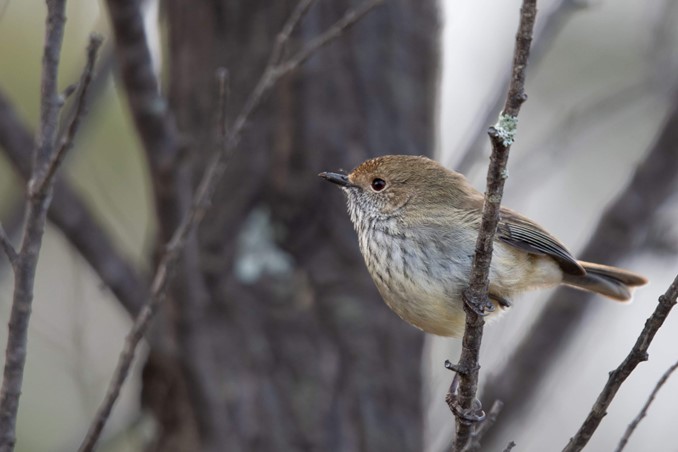The Brown Thornbill (Acanthiza pusilla) is one of the more common thornbills, although many birders have struggled to identify this small brown passerine through the scrub. As can be assumed from the name; most of this bird is brown, with the forehead and rump approaching rufous. The eye is red, the throat and breast pale and streaked. The specific epithet pusilla comes from the Latin pusillus, which means ‘very small’. The generic name Acanthiza comes from akantheōn ‘thorn’ and zaō ‘to inhabitat’.
There are currently 5 subspecies recognised; here in Queensland we have both the nominate race pusilla which occurs from the NSW border to Gladstone, and dawsonensis which occurs from Gladstone to Bowen (differentiated by a slightly shorter tarsus).
The western and southern edges of its range overlap with the similarly plumaged Inland and Tasmanian Thornbills. The Brown can be distinguished from Inland by having a proportionally shorter tail, and brown scalloping on the forehead — different to the Inland’s blacker scalloping. Differentiating from the Tasmanian is much harder. The throat of Tasmanian appears mottled or greyish, compared to the streaking of the Brown. The forehead, while the same rufous colour, lacks the scalloping of the Brown.

They favour areas with a dense shrub layer, be it wet eucalypt, rainforest, or heathland. In eucalypt forests, this thicker vegetation often manifests in dark creek lines and gullies. However I often find them enjoying dense thickets of Lantana camara, an invasive weed that many small birds love. It has been theorised that they may benefit from logging activities, as the added light increased the density of low vegetation. Primarily insectivores, Brown Thornbills can be seen carefully flitting amongst leaves and shrubs to glean insects.
However, they are typically heard before they are spotted, a complex, rippling trill. This song often varies in duration, pitch, and complexity, leading ornithologist John Latham to refer to them as ‘Dwarf Warblers’. I often hear the pairs softly calling to each other as they forage; a constant game of Marco Polo.

This is the view most people get of this species, a plain tiny bird in dense vegetation. But even at this distance, the streaked throat and rufous forehead are noticeable.

Brown Thornbills are monogamous and defend their territory year-round, which can range from 0.25 ha to 3.5 ha. Only the females have been found to incubate, but both parents share equally in rearing. The clutches are small; only around 3 eggs. However, their relatively long breeding season (around 4 months) means that they can occasionally raise two broods a year.
Small groups are more likely to be families instead of non-breeding flocks, as juveniles can stay with their parents for at least 8 weeks. When they eventually disperse from their natal territory, the daughters typically leave first. Some sons may leave at the same time, while others delay their dispersal and are tolerated by their parents throughout their first autumn and winter.

They are also known to mimic the alarm calls of other species when threatened. One study found that they imitated 17 different species when disturbed, from Superb Fairywrens to Pied Currawongs. Most of these calls are ‘aerial alarm calls’, designed to warn others about the presence of a raptor. This serves to give momentary panic to a potential threat, allowing the Thornbills to escape.
However, the majority of their vocalisations are still yet to be understood — there is always more to learn about these small secretive birds.
Further Reading:
- Marchant, S., & Higgins, P. J. (1990). The Handbook of Australian, New Zealand and Antarctic Birds.
- Igic, B., & Magrath, R. D. (2013). Fidelity of vocal mimicry: identification and accuracy of mimicry of heterospecific alarm calls by the brown thornbill. Animal Behaviour, 85(3), 593–603. https://doi.org/10.1016/j.anbehav.2012.12.022
- Green, D. J., & Cockburn, A. (1999). Life history and demography of an uncooperative Australian passerine, the brown thornbill. Australian Journal of Zoology, 47(6), 633. https://doi.org/10.1071/zo99052
- Boles, W. E. (1983). A Taxonomic Revision of the Brown Thornbill Acanthiza Pusilla (Shaw) 1790 with Description of a New Sub-Species. Emu, 83(2), 51–58. https://doi.org/10.1071/mu9830051


